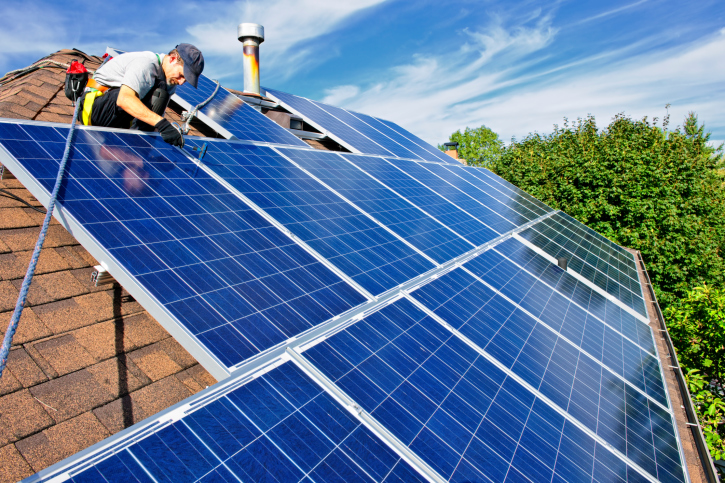The California Public Utilities Commission (CPUC) has proposed updating the rules for how the state’s 1.3 million owners of rooftop solar systems will be compensated.
In states with renewable energy mandates, rooftop solar customers sell excess power generated by their systems back to the local utility. By law, utilities are usually forced pay the retail rate they charge customers for power, for the excess electricity generated by rooftop systems, rather than the wholesale rate they pay other power generation sources.
Usually the rooftop solar owner receives the compensation in the form of a credit on the monthly power bill.
Customers who have installed rooftop solar panels also rarely pay for the enhanced or additional equipment utilities must operate and maintain specifically to manage delivering and receiving, on a moment by moment basis, power to and from intermittent rooftop solar systems.
California and most other states currently shift those additional costs to ratepayers at large in the retail electricity prices they pay.
Shifting Solar Costs
The proposal released by the CPUC in mid-December 2021, would shift the additional cost to utilities of managing roof-top solar systems from ratepayers in general to the systems’ owners.
In addition to a one time interconnection fee, the CPUC has proposed adding a “Grid Participation Charge” of $8 per kilowatt of installed solar, which the agency says will allow utilities to “capture residential adopters’ fair share of costs to maintain the grid and fund public purpose programs.”
The California Solar & Storage Association has estimated this fee will add between $40 and $48 per month to the bill of grid connected roof-top solar owners serviced by San Diego Gas & Electric.
Electric Vehicle Comparison
The current regulatory regime is similar to the types of cost shifting electric vehicle (EV) owners benefit from, says William F. Shughart II, Ph.D., the J. Fish Smith Professor in Public Choice at the Jon M. Huntsman School of Business at Utah State University.
“To the extent that the owners of EVs do not purchase motor fuel, they do not generate gas tax revenue for the ‘highway trust funds’ established in most states and at the federal level, which are supposedly earmarked for building and maintaining roads and bridges,” Shughart said. “Many states have begun levying fixed fees on EV owners to make up the highway-trust-fund shortfall.
“Any fee will, of course, slow down the installation of solar panels on existing homes, although the extra charges apparently don’t kick in until panels have been generating power for 15 years, a seemingly arbitrary time delay,” said Shughart. “California now mandates solar panels on all new homes and apartment buildings, a rule that, by itself, raises construction costs and contributes to the state’s already very high home prices and its serious homelessness problem.”
To fee, or not to fee misses the most important point in the electric power debate, which should be grid reliability, says Shughart.
“The most important issue, in my judgment, is the rush to install solar panels and wind farms threatens to compromise the reliability of California’s grid,” said Shughart. “As seen there and in Texas brownouts and blackouts rear their ugly heads in severe weather, hot or cold, unless enough fossil fuel or nuclear generated power can be brought online quickly to meet unusually heavy energy demands, which is why diversity in energy supply is crucial.”
Current Rules Harm the Poor
The current regulatory system benefits solar power owners but increases the cost of electricity for the poor, including many of the 18 million Hispanic and African Americans residing in the state, says energy consultant, Ronald Stein, founder of PTS Advance.
“The CPUC’s proposal would rectify the higher costs imposed on the poor by current solar power subsidies,” said Stein. “San Diego Gas & Electric and Southern California Edison have jointly proposed a sharp decrease in solar subsidies, as well as a monthly connection charge for roof top solar systems, a double whammy that will slow the transition to solar panels by shifting the costs of the systems from non-users, including the poor, to users.
“Only healthy and wealthy countries like the United States, Germany, Australia, and the UK, can afford to subsidize electricity from breezes and sunshine,” said Stein. “By contrast, the 80 percent of the people worldwide living on less than 10 dollars a day cannot subsidize themselves out of a paper bag and need affordable and abundant coal for reliable electricity.
“Sadly, the less-fortunate residents in wealthier countries pay dearly for those wind and solar subsidies with higher costs for electricity,” Stein said.
Benefitting From Complex Subsidies
The CPUC’s plan is a step in the right direction, says Wayne Winegarden, Ph.D., a senior fellow with the Pacific Research Institute.
“The solar industry benefits from a complex web of subsidies, one of which is allows customers to effectively sell their excess energy back to the grid at retail rates,” Winegarden said. “The current reimbursement scheme overcompensates solar power owners because home generators should not receive compensation for the distribution and transmission services they did not provide.
“This distortion leads to many inefficiencies, including shifting costs from houses with solar panels to those without, which means shifting costs from wealthier to poorer households,” said Winegarden. “Solar power can be a valued product but people should not be subsidized for purchasing solar panels for their roofs; households that want solar energy should pay for the costs, which should be the overarching principle guiding all regulations.”
Kenneth Artz (KApublishing@gmx.com) writes from Dallas, Texas.
